Sitting at a refreshing altitude of over 7,700 feet above sea level, Addis Ababa is a lush and cool place to visit. Though Ethiopia is very much a developing country, there is a stability in this city that is often lacking in other urban centers on this continent.
While things may not run as smoothly as back home, this city of a three and a half million people is not the basket case than many people think it is.
Addis Ababa is a melting pot. It’s vibrant. The city is alive with the hum of different languages and the swirl of traditions. Markets buzz with artisans. Modern art galleries stand alongside. Here, the past and the future dance in the streets. It’s where “New Flower” blooms amidst the highlands, welcoming travelers with open arms. This city is a living museum, a place where every street and alley tells a tale.
Feast For Your Senses
The food? Unforgettable. Injera with spicy stews brings people together, turning meals into celebrations. And the coffee? It’s an experience, a ritual that invites conversation and connection.
Addis isn’t just Ethiopia’s capital. It’s Africa’s diplomatic capital too. The city’s significance on the global stage is echoed in its museums and cathedrals. They tell stories of a proud past and a hopeful future.
Addis Ababa is more than a stopover; it’s a journey into the essence of Ethiopia. Its contrasts are its charm. The city doesn’t just welcome you; it captivates, offering tastes, sights, and stories that linger long after you’ve left. In Addis, every corner has a story, and every story invites you to listen.
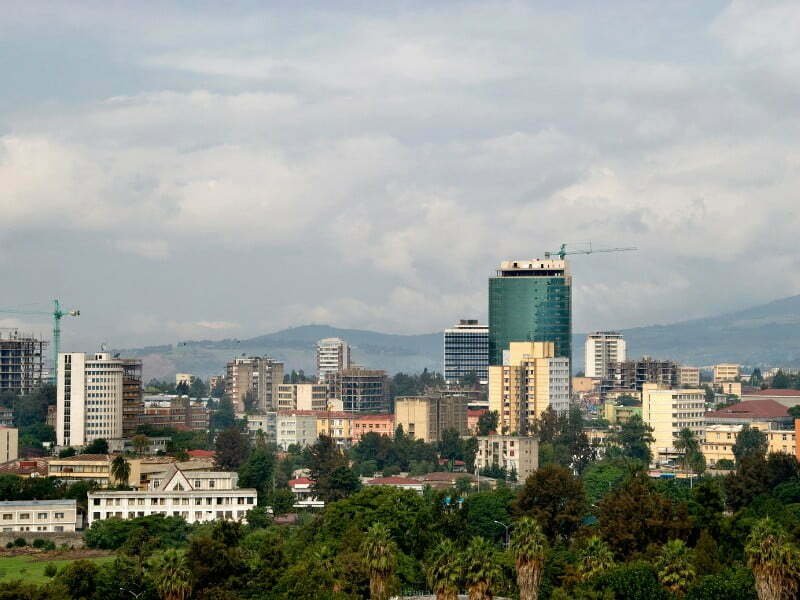
Addis Ababa City Guide: A Brief History Of Addis Ababa, Ethiopia
Dive into the heart of Ethiopia and discover Addis Ababa, a city where history whispers from the Entoto Hills and the vibrant streets hum with the promise of the future. This isn’t just a city; it’s a living museum, a testament to Ethiopia’s enduring spirit and a beacon of African independence.
A Royal Beginning
Perched within the embrace of the Entoto Hills, Addis Ababa’s tale commences in 1886. It was here that Emperor Menelik II, seeking a fresh start for his empire, planted the seeds of what would blossom into a vibrant capital. The name “New Flower,” bestowed by Empress Taytu Betul, reflected not just the physical beauty of the area but also the hope for a new era. From a modest encampment, the city unfolded like a tapestry, weaving together threads of ambition, culture, and resilience.
The Italian Footprint
As the 20th century dawned, Addis Ababa encountered a pivotal chapter in its history – the Italian occupation. This period left an indelible mark on the city’s architectural and culinary landscape, infusing it with a unique blend of Italian and Ethiopian influences. From the Piazza, reminiscent of Rome’s open squares, to the fusion of pasta and injera on dinner tables, the occupation is a reminder of the city’s ability to evolve and adapt. Yet, the true legacy of this era is the spirit of resistance and independence that it ignited among the Ethiopian people.
A Center of Learning and Faith
Addis Ababa is not merely Ethiopia’s political heart but also its spiritual and intellectual soul. The city is dotted with institutions of faith and education, like the Holy Trinity Cathedral, a beacon of Ethiopian Christianity, and the Addis Ababa University, where the country’s future leaders are forged. These sites are more than landmarks; they are the pillars of the community, offering solace and wisdom to all who seek it.
The Pulse of Modernity
Today, Addis Ababa stands at the crossroads of tradition and modernization. The city skyline, a silhouette of cranes and high-rises against the backdrop of the lush Entoto, symbolizes a nation in flux. Yet, amidst this rapid growth, the essence of Addis Ababa remains unchanged. The warmth of its people, the richness of its culture, and the depth of its history continue to enchant all who wander its streets.
Legacy of Liberation
Perhaps the most profound chapter in Addis Ababa’s history is its role as a symbol of pan-African unity and freedom. The city’s selection as the headquarters for the African Union is no mere coincidence; it is a testament to Ethiopia’s historical significance as a beacon of independence on a continent all too familiar with colonization. The AU’s towering presence in Addis Ababa is a constant reminder of the city’s commitment to unity, peace, and progress across Africa.

Addis Ababa Top Attractions and Best Places to Visit in Ethiopia
Begin your time in Addis Ababa by paying your respects to the victims of one of the brutal regimes of the 20th century at the Red Terror Martyrs Memorial Museum. The communist Derg took power following a coup in 1974.
They ruled Ethiopia with an iron fist, with anyone who opposing their regime being systematically executed over the 15 years that they held power. This institution in Addis Ababa tells the story of The Derg’s ultraviolent approach to governance, with exhibits displaying skulls and bones, bloodied clothing, and photographs of their political victims.
Museum guides often include relatives of those who met their end at the hands of this government, giving this experience a weight that will make you appreciate the relatively stable, democratic governments we have at home.
More Attractions
After learning about the darker periods of Ethiopia’s history, get a background in this nation’s cultural heritage by paying a visit to the Ethnological Museum. Also known as the National Museum of Ethiopia, it can be found within the palace of Haile Selassie, Ethiopia’s last emperor.
Assassinated by the Derg in 1974, his legacy is a more positive one, as his former home has been transformed into one of Africa’s finest museums. It delves deep into the traditions of Ethiopia’s various cultures, with rite of passage rituals, tribal medicine, handicrafts, burial traditions, and many other aspects of daily life in this ancient nation being covered in detail.
After Armenia, Ethiopia is the world’s oldest Christian nation. While there are churches in the countryside that are more impressive than what you will find in Addis Ababa, make time nonetheless to check out the Holy Trinity Cathedral.
Built to celebrate the liberation of Ethiopia from Mussolini, the remains of some of this country’s most important figures have been laid to rest within its walls. This includes Ethiopian emperor Haile Selassie, prime minister Meles Zenawi, resistors of the Italian occupation, and other important figures.
Apart from the tombs, this place is also known for decorative stained glass windows; when you arrive however, do remember to take your shoes off as per local tradition.

Other Cultural Attractions: Trip to Addis Ababa, Ethiopia
Those wanting to dive deeper into Ethiopia’s history will want to pay their respects at the Mausoleum of Menelik II. As the name suggests, it is a place of rest for this Ethiopian Emperor, but it also contains the sarcophagi of other emperors and Imperial family members as well. You will feel the history of this place as soon as you step through the trap door allowing access to the room where their coffins are situated.
There’s also a painting within the mausoleum that is rumored to have been painted by Michelangelo. According to guides, the directors of the mausoleum were offered 20 million pounds for it but refused the offer.
With a complete lack of security surrounding the work, whether it is an original or not is up for debate, but it certainly looks great in this historic hall regardless.
For The Culture Vulture
Market lovers should not leave the city without checking out Addis Mercato. With over 7,000 stalls employing over 13,000 people, it is the largest open-air market in Africa. While it is a very crowded place, the cultural authenticity of this place will make up for any discomfort that you might feel during your time here.
Goods of all kinds are sold here and you will often see the locals taking away their purchases on their head. Don’t attempt to follow their lead: instead, pay rapt attention as you explore, as this sprawling market is a prime habitat for pickpockets.
Before leaving Addis Ababa, hire a taxi and tell them to take you to Entoto Hill. In addition to the palaces and museums that you will find up here, the prime attraction are the large stands of eucalyptus trees that make this place the best green space in Addis Ababa.
There are also amazing views of the city below, so photographers should make the trip up here at some point during their visit.
source: Where in the World is cL on YouTube
Top 20 Things To Do in Addis Ababa, Ethiopia For Visitors
From its museums and historical sites to its vibrant art and music scene, there is no shortage of things to do and see in this vibrant city. Here are twenty top activities to consider when exploring Addis Ababa:
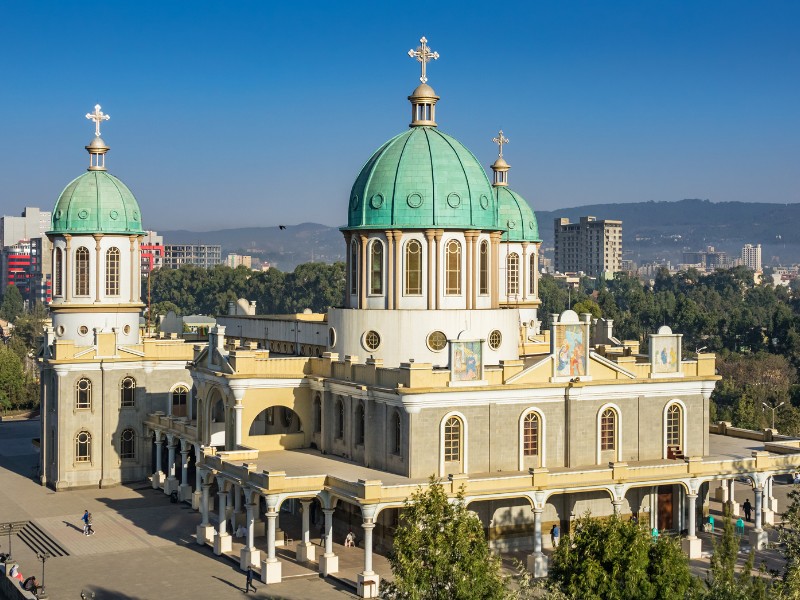
1) Visit the Holy Trinity Cathedral
The Holy Trinity Cathedral is not only a place of worship but also a resting place for Emperor Haile Selassie and his wife. The cathedral’s interior is stunning, adorned with intricate murals and stained-glass windows, illustrating the religious and historical narrative of Ethiopia. Outside, peaceful gardens offer a quiet space for reflection amidst the city’s bustle.
- Must-see: The elaborate stained-glass windows.
- What to explore: The tombs of Haile Selassie and his family.
- Tip: Arrive early to avoid the crowds and enjoy the serene atmosphere.
2) Stroll Through Meskel Square
Meskel Square is the beating heart of Addis Ababa, known for its vibrant festivals, including the annual Meskel Festival. During the day, it’s a hub of city life, offering a glimpse into the fast pace of the Ethiopian capital. At night, the square comes alive with locals and visitors enjoying the open space.
- What to see: Major public events like the Meskel Festival.
- Best time to visit: Early evening to see the square bustling with activity.
- Tip: It’s a great starting point for walking tours of the city.
3) Shop at Addis Mercato
Dive into the lively and chaotic world of Addis Mercato, Africa’s largest open-air market. Here, you can find everything from spices and traditional textiles to electronics and handmade crafts. The market is an authentic Ethiopian experience, full of energy and hustle, and a great place to find unique souvenirs.
- What to buy: Local spices, traditional garments, and crafts.
- Best for: Bargain hunters and curious travelers.
- Tip: Be prepared to haggle for the best prices.
4) Enjoy the Views from Entoto Hill
For breathtaking views of Addis Ababa, head to Entoto Hill, a popular spot for both photographers and nature lovers. It’s also home to the Entoto Maryam Church and the former palace of Emperor Menelik II, offering a mix of history and nature. The hike up is worth the effort, but there are also car services for those who prefer a more relaxed journey.
- Top sights: Entoto Maryam Church and Emperor Menelik II’s palace.
- Best time to visit: Late afternoon for golden-hour views.
- Tip: Bring a jacket—temperatures can drop at higher altitudes.
5) Discover the Ethnological Museum
Housed in the former palace of Emperor Haile Selassie, the Ethnological Museum gives an in-depth look at Ethiopia’s rich cultural tapestry. The museum covers various aspects of Ethiopian life, from traditional clothing and musical instruments to religious artifacts. It’s a fascinating journey through the country’s diverse ethnic groups and history.
- Must-see exhibit: The religious artifacts and emperor’s personal quarters.
- Best for: Culture enthusiasts and history lovers.
- Tip: Combine your visit with a stroll around Addis Ababa University’s beautiful campus.
6) Relax in Unity Park
Unity Park is a relatively new addition to Addis Ababa, located within the Grand Palace compound. It celebrates Ethiopia’s unity and diversity, featuring beautifully landscaped gardens, historical exhibits, and a small zoo. It’s a great place to relax and reflect, while also learning about the country’s past and future.
- Best features: Cultural exhibits and the Grand Palace grounds.
- Tip: Opt for a guided tour to fully appreciate the historical significance.
- Perfect for: A peaceful retreat and cultural exploration.
7) Take a Culinary Tour
Ethiopian cuisine is an explosion of flavors and tradition. Join a culinary tour to taste local dishes like injera (sour flatbread) served with various stews and vegetables. Don’t miss the traditional coffee ceremony, where freshly roasted beans are ground, brewed, and shared. It’s an immersive way to experience Ethiopian hospitality.
- What to try: Injera with doro wot (chicken stew) and kitfo (minced raw beef).
- Best for: Foodies and cultural explorers.
- Tip: Try the tej (honey wine) for a truly authentic experience.
8) Visit the Red Terror Martyrs Memorial Museum
The Red Terror Martyrs Memorial Museum offers a sobering look into one of Ethiopia’s darkest periods under the Derg regime. Through personal accounts, photographs, and exhibits, the museum commemorates the lives lost during the Red Terror. It serves as a powerful reminder of the importance of peace and human rights.
- Main exhibit: Personal testimonies and artifacts from the Red Terror.
- Tip: Take your time to absorb the emotional impact of the museum.
- Best for: History buffs and those interested in human rights.
9) Explore the Shola Market
Smaller and more laid-back than Mercato, Shola Market offers a more intimate shopping experience. You’ll find everything from fresh produce and spices to handmade crafts, giving you a true taste of local commerce. It’s a great place to mingle with locals and pick up some fresh ingredients or unique souvenirs.
- Best finds: Fresh produce, spices, and handmade goods.
- Best for: Local interaction and a more relaxed market atmosphere.
- Tip: Arrive early to get the freshest produce.
10) Attend a Traditional Ethiopian Coffee Ceremony
A highlight of Ethiopian culture, the coffee ceremony is an event not to be missed. The process is elaborate, starting with roasting green coffee beans over a flame and ending with serving freshly brewed coffee in small cups. The aroma fills the air, and the experience is as much about hospitality as it is about enjoying coffee.
- What to expect: Freshly roasted and ground coffee served in small cups.
- Tip: It’s often accompanied by popcorn or kolo (roasted barley).
- Best for: Coffee lovers and cultural enthusiasts.
11) Stroll Through Friendship Park
Friendship Park is an oasis of greenery in the heart of Addis Ababa. The park is designed with walking paths, water features, and plenty of green space, providing a perfect spot to unwind. It’s a wonderful place for a leisurely stroll, with outdoor fitness equipment and playgrounds for families.
- Best for: Relaxation, outdoor exercise, and family outings.
- Tip: Pack a picnic and spend a peaceful afternoon by the water.
- Perfect for: Escaping the urban hustle while staying in the city.
12) Admire Art at the Zoma Museum
For art lovers, the Zoma Museum offers a unique space where contemporary and traditional Ethiopian art come together. The eco-friendly buildings are made from sustainable materials, blending art with environmentalism. The museum’s installations and edible gardens create a truly immersive experience.
- What to see: Contemporary Ethiopian art and eco-architecture.
- Best for: Art lovers and environmentally conscious travelers.
- Tip: Explore the edible garden to see how art and sustainability intersect.
13) Catch a Performance at the National Theatre
The National Theatre of Ethiopia is a hub for performing arts, showcasing everything from traditional Ethiopian dance to modern plays and concerts. The theater’s mid-20th-century architecture is also worth admiring, adding to the cultural experience. It’s the perfect way to spend an evening in Addis Ababa.
- What to watch: Traditional dance performances or modern Ethiopian plays.
- Best for: Culture seekers and performing arts enthusiasts.
- Tip: Check the schedule ahead of time for upcoming shows.
14) Visit the Lion Zoo
A smaller attraction but significant for conservation, the Lion Zoo in Addis Ababa focuses on the preservation of Ethiopian lions with their distinctive dark manes. While the zoo is small, it offers visitors a chance to see these majestic creatures up close while raising awareness of conservation efforts.
- Best for: Families and wildlife lovers.
- What to see: The Ethiopian lions and other native wildlife.
- Tip: Visit during feeding time for an exciting experience.
15) Wander Through the Yeka Forest
Just outside the city limits, the Yeka Forest offers a refreshing break from the urban environment. The forest is filled with endemic plants and wildlife, making it a great spot for birdwatching and nature walks. The trails also lead to several viewpoints offering stunning vistas of Addis Ababa.
- Best for: Nature lovers and birdwatchers.
- Tip: Bring binoculars for a closer look at the diverse bird species.
- Perfect for: A quiet escape from the city’s hustle.
16) Learn at the Science Museum
The Science Museum is an educational space dedicated to promoting science and technology in Ethiopia. With interactive exhibits that cover a wide range of topics—from biology to space exploration—it’s a great stop for families or anyone with an interest in science. It’s both fun and educational.
- What to see: Interactive exhibits onscience, technology, and more. It’s an interactive experience, making it a fun stop for families and curious minds alike. Here, visitors can engage with exhibits about space, physics, and biology while learning about Ethiopia’s growing focus on innovation and education.
- Best for: Families, students, and science enthusiasts.
- What to see: Hands-on exhibits, science experiments, and educational activities.
- Tip: Check the schedule for workshops or special science events during your visit.
17) Explore the Holy Raguel Church

What To Eat and Drink in Addis Ababa, Ethiopia
Ethiopian cuisine is famous for its unique blend of flavors, spices, and use of injera, a spongy flatbread made from teff flour. Addis Ababa is the perfect place to experience traditional Ethiopian dishes, as it is the country’s culinary hub.
Here’s a detailed guide to what to eat and drink when you find yourself in this vibrant city, ensuring you don’t miss out on the unique tastes that Ethiopian cuisine has to offer.
1. Injera with Doro Wat
Injera, a sourdough-risen flatbread with a unique, slightly spongy texture, is a staple in Ethiopian cuisine. It’s traditionally served with Doro Wat, a spicy chicken stew that’s considered Ethiopia’s national dish. The stew is made with berbere spice, onions, garlic, and sometimes hard-boiled eggs.
2. Tibs
Tibs is a popular Ethiopian dish consisting of pan-fried meat chunks (usually beef, lamb, or goat) sautéed with onions, garlic, and sometimes rosemary. It can be served spicy or mild and is often accompanied by vegetables and injera. Tibs can be found in many variations across Addis Ababa, from street food stalls to upscale restaurants.
3. Kitfo
Kitfo is a traditional dish made from raw minced beef, marinated in mitmita (a spicy chili powder blend) and niter kibbeh (clarified butter infused with herbs and spices). It’s often served with injera and a side of ayib (Ethiopian cottage cheese). For those less adventurous, a cooked version, known as leb leb, is also available.
4. Shiro
Shiro is a hearty and comforting stew made from ground chickpeas or broad bean meal. It’s cooked with berbere spice, onions, tomatoes, and garlic and is typically served atop injera. This dish is particularly popular during fasting periods when meat is not consumed.
5. Beyaynetu
Beyaynetu is a vegetarian platter that offers a variety of Ethiopian vegetarian dishes on a single piece of injera, making it a perfect option for vegetarians and vegans. Common components include lentils, split peas, and collard greens, each prepared in distinct and flavorful ways.
6. Coffee
Ethiopia is the birthplace of coffee, and experiencing a traditional Ethiopian coffee ceremony is a must. The coffee is prepared in a clay pot called a jebena and is often accompanied by the burning of frankincense. The result is a strong, aromatic coffee usually served with sugar or sometimes salt.
7. Tej
Tej is a traditional Ethiopian honey wine that’s both sweet and potent. It’s made from fermented honey and a type of leaves known as gesho, serving as hops do in beer brewing. Tej is typically served in a special flask called a berele.
8. Tella
Tella is traditional Ethiopian homemade beer brewed from barley, maize, or millet. It has a slightly sour taste and is less alcoholic than tej. Tella bars, where locals gather to drink and socialize, are a common sight in Addis Ababa.
9. Sambusas
Sambusas are Ethiopian versions of samosas – triangular pastry shells filled with spiced meat or lentils. They are a popular snack or appetizer, crispy on the outside with a flavorful filling, perfect for starting off any meal.
10. Genfo
Genfo is a dense porridge made from barley, wheat, or sorghum flour, often served for breakfast. It’s typically eaten with spiced clarified butter and a dollop of yogurt or honey. Genfo provides a hearty and filling start to the day.
11. Firfir
Firfir is a breakfast dish made from shredded injera or leftover bread soaked in spicy berbere sauce or niter kibbeh. Sometimes meat is added, making it a savory and spicy dish to kickstart the morning.
Addis Ababa’s vibrant food and drink scene offers visitors a chance to experience traditional Ethiopian cuisine and beverages. From injera to doro wat, tej to tella, there is no shortage of delicious and unique flavors to discover in this bustling city.
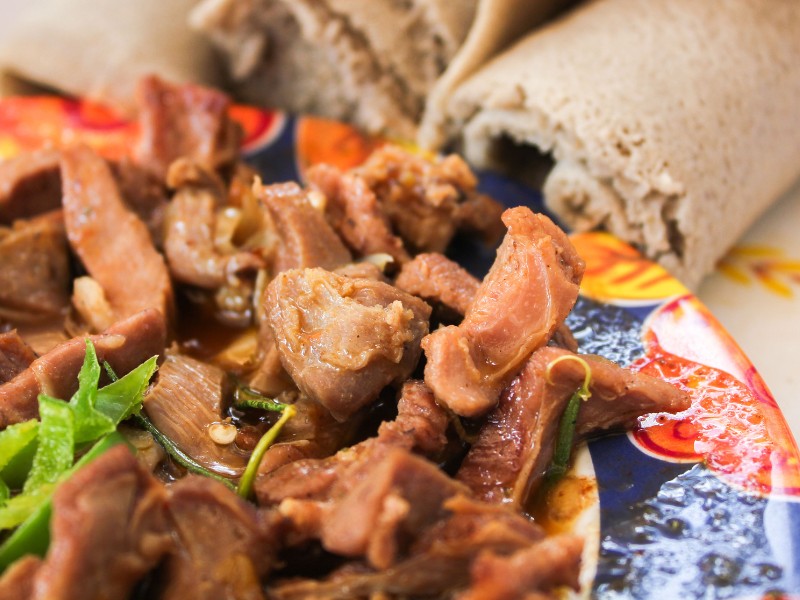
Top Restaurants In Addis Ababa, Ethiopia
Here’s a roundup of the top restaurants that promise an unforgettable dining experience.
Yod Abyssinia: A Cultural Feast
No visit to Addis Ababa is complete without experiencing a traditional Ethiopian meal, and Yod Abyssinia offers just that. It’s more than a restaurant; it’s a cultural immersion. Guests are treated to vibrant live music and dance performances while enjoying injera with a variety of hearty stews. The ambiance, buzzing with energy and Ethiopian hospitality, makes every visit memorable.
Kategna: The Flavor of Tradition
Kategna takes Ethiopian cuisine to another level with its authentic dishes and warm, inviting atmosphere. From the moment you step in, the aroma of spices and freshly roasted coffee envelops you. The menu features an array of traditional dishes, each prepared with meticulous care. Don’t miss their kitfo, a delicately spiced minced beef delicacy that melts in your mouth.
Mama’s Kitchen: A Modern Twist
Mama’s Kitchen is where Ethiopian cuisine meets international flavors, creating a fusion that’s both innovative and delicious. With a modern, chic setting, it’s a favorite among locals and travelers alike. Their menu is a testament to the chef’s creativity, offering dishes like tibs panini alongside classic Ethiopian fare. The live jazz nights add a layer of sophistication to the dining experience.
Five Loaves: The Health-Conscious Choice
In the heart of Addis, Five Loaves is a haven for those seeking healthy, yet flavorful, meal options. This cozy cafe specializes in organic dishes, smoothies, and an assortment of vegan and vegetarian delights. The ambiance is calm and inviting, making it the perfect spot for a relaxed meal. Their fresh salads and wholesome sandwiches are a hit among health-conscious diners.
Gusto Restaurant: A Taste of Italy
Gusto Restaurant offers a slice of Italy in Addis Ababa. Known for its authentic Italian cuisine, the restaurant boasts a menu filled with classic dishes like pasta, pizza, and risotto, all prepared with a touch of Ethiopian flair. The elegant setting and extensive wine list complement the dining experience, making it ideal for a romantic evening or a special celebration.
La Mandoline: French Elegance
Nestled in a charming villa, La Mandoline exudes French elegance and sophistication. The menu, a blend of French classics and contemporary dishes, is curated to perfection. Dining here feels like a Parisian escape, with the escargot and beef bourguignon as standout dishes. The serene garden seating offers a tranquil dining experience amidst the city’s hustle.
Dashen Traditional Restaurant: Dive into History
Dashen Traditional Restaurant is a journey back in time, offering a glimpse into Ethiopia’s rich culinary history. Set in a traditional Ethiopian home, diners can enjoy time-honored recipes that have been passed down through generations. The tej (honey wine) is a must-try, perfectly complementing the spicy and flavorful dishes. The restaurant’s dedication to preserving Ethiopian culinary traditions is evident in every bite.
Sichuan Restaurant: A Spicy Adventure
For those craving a spicy kick, Sichuan Restaurant delivers with its authentic Chinese Sichuan cuisine. The fiery dishes, loaded with bold flavors and spices, are a testament to the chef’s expertise. It’s a favorite spot for both expats and locals, offering a taste of China in the heart of Ethiopia. The mapo tofu and spicy chicken are crowd-pleasers.
Bait Al Mandi: Arabian Nights
Bait Al Mandi transports diners to the Middle East with its exquisite Arabian cuisine and decor. Specializing in mandi, a traditional Yemeni dish, the restaurant offers a dining experience that’s both authentic and aromatic. The warm, welcoming ambiance and generous portions make it a popular choice for family gatherings. The lamb mandi, slow-cooked to perfection, is a culinary masterpiece.
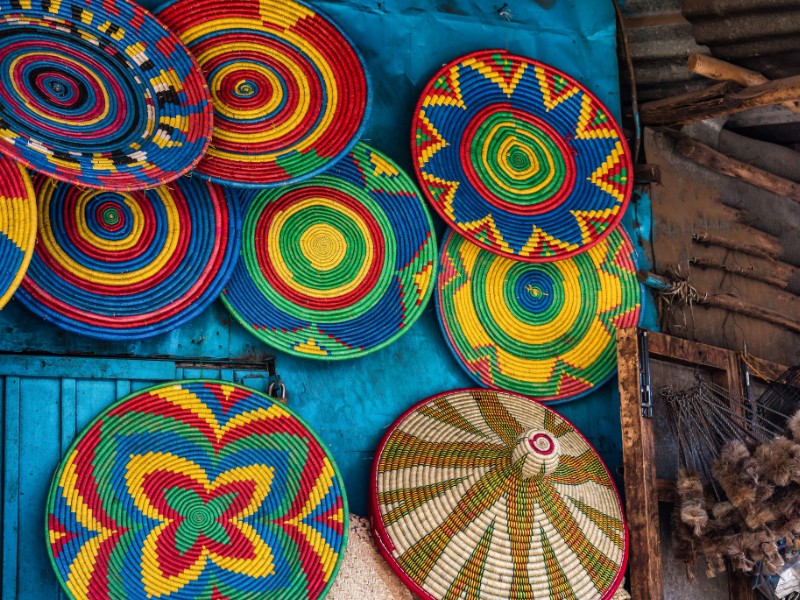
Tours For Visitors To Addis Ababa, Ethiopia
Here’s a detailed guide to the top tours that cater to diverse interests, ensuring every traveler finds a path that resonates deeply with their curiosities and passions.
1. Historic Heartbeat Tour
Imperial Legacies: Walk through the palatial grounds where emperors envisioned Ethiopia’s future. Visit the National Museum to see Lucy, traverse Menelik II’s palace, and feel the solemnity at the Holy Trinity Cathedral.
Insider Insight: Guides provide narratives that weave together Ethiopia’s past with its present, offering a deeper understanding of its enduring legacy.
2. Culinary Delights Tour
Taste of Ethiopia: A journey through Addis Ababa’s vibrant markets and traditional restaurants. Learn the art of making injera, savor dishes like doro wat, and participate in a coffee ceremony.
Flavorful Memories: This tour isn’t just about tasting; it’s about creating dishes that you can bring back home, a savory memory of Ethiopia.
3. Art and Soul of Addis Tour
Creative Pulse: Explore the city’s booming art scene, from contemporary galleries in Bole to street art that colors the Mercato. Meet local artists, understand their inspirations, and maybe even create your own piece.
Cultural Fusion: This tour highlights how Ethiopia’s rich heritage blends with modern expressions, creating a vibrant arts scene.
4. Addis Architecture and Design Tour
Structural Stories: Discover architectural marvels, from traditional Ethiopian homes to Italian Art Deco remnants and the futuristic African Union Headquarters.
Design Dialogue: Learn about the influences and ideas shaping Addis Ababa’s skyline and how architecture tells the story of a city in flux.
5. Green Spaces and City Views Tour
Urban Oasis: Escape to the Entoto Mountains for breathtaking views and serene forest walks. Visit the Suba Menagesha forest, one of the oldest in Africa.
Eco Insights: This tour emphasizes Addis Ababa’s commitment to green spaces amidst urban growth, offering a fresh perspective on city planning.
6. Spiritual Pathways Tour
Holy Sites: Experience the spiritual diversity of Addis Ababa by visiting ancient Orthodox churches, mosques, and the unique St. George Cathedral.
Faithful Reflections: Understand the role of religion in Ethiopian daily life and enjoy moments of contemplation and peace in these sacred spaces.
7. Local Life and Markets Tour
Bustling Bazaars: Dive into the Mercato, one of Africa’s largest open-air markets. Discover Shiro Meda’s textile market, offering traditional fabrics and garments.
Everyday Ethiopia: This tour offers a glimpse into the daily hustle, showcasing how locals shop, trade, and maintain centuries-old traditions.
8. Nightlife and Live Music Tour
Vibrant Evenings: Experience Addis Ababa after dark. Enjoy traditional Azmari performances, modern live music, and maybe even some Ethiopian jazz.
Cultural Celebration: Learn how music and dance are integral to Ethiopian social life, providing a lively end to your day.
9. Political and Diplomatic Tour
Center of Africa: Visit the African Union Headquarters and understand Ethiopia’s pivotal role in continental politics.
Peaceful Ambitions: The tour delves into Ethiopia’s efforts in peacekeeping and diplomacy, highlighting its influence beyond its borders.
10. Coffee and Cuisine Workshop Tour
Brewing Traditions: Participate in a coffee ceremony, learning the rituals and stories behind Ethiopia’s famous brews. Cook alongside local chefs to create traditional meals.
Culinary Craft: This hands-on tour not only allows you to taste but also to create, offering skills to bring a piece of Ethiopia home with you.
11. Addis Ababa’s Urban Art and Graffiti Tour
Street Canvases: Explore the city’s vibrant street art scene, featuring works that range from political statements to cultural celebrations.
Artistic Voices: Meet with local street artists to hear about their inspirations and challenges, providing a colorful narrative to the city’s walls.
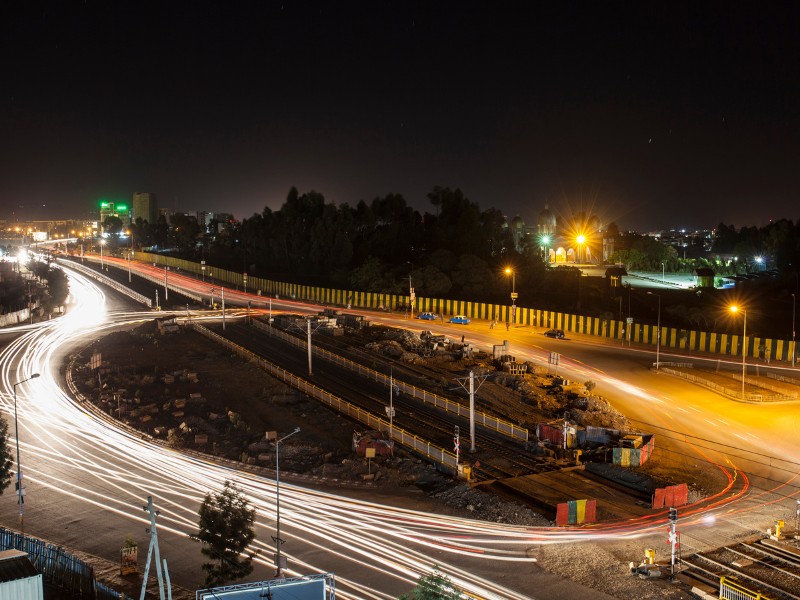
Addis Ababa Accommodations Guide: Hotels, Guesthouses and Hostels
This guide covers a spectrum of accommodations in Addis Ababa, from luxurious hotels to cozy guesthouses and budget-friendly hostels.
Luxury Hotels
Sheraton Addis
A symbol of luxury, the Sheraton Addis stands on a hilltop overlooking the city with its elegant rooms, world-class services, and lush gardens. With multiple restaurants, swimming pools, and a state-of-the-art spa, it caters to those seeking an indulgent stay.
The Skylight Hotel
Owned by Ethiopian Airlines, this hotel is strategically located near the airport, making it perfect for business travelers. It boasts spacious rooms, Ethiopian cultural shows, and a rooftop bar with stunning views of the city.
Radisson Blu Hotel, Addis Ababa
Offering a blend of modern comfort and Ethiopian hospitality, the Radisson Blu is ideal for both leisure and business travelers. Its central location provides easy access to key attractions and business centers.
Mid-Range Hotels
Golden Tulip Addis Ababa Hotel
A great mix of comfort and convenience, the Golden Tulip provides well-appointed rooms, excellent dining options, and professional service, all in a central location close to shopping and cultural sites.
Capital Hotel and Spa
Offering a serene and welcoming atmosphere, this hotel features spacious rooms, Ethiopian cuisine, and a relaxing spa. It’s a perfect base for exploring Addis Ababa’s attractions.
Harmony Hotel
With its contemporary design and friendly service, Harmony Hotel is a favorite among visitors. It includes amenities like a fitness center, spa, and multiple dining options, ensuring a comfortable stay.
Budget-Friendly Hotels
Ag Palace Hotel
For those seeking affordability without compromising on comfort, Ag Palace Hotel offers clean, cozy rooms and warm hospitality. It’s located in a quieter part of the city, providing a peaceful retreat.
Caravan Hotel
A budget-friendly option with a homely atmosphere, the Caravan Hotel has simple yet comfortable rooms and an on-site restaurant serving delicious local and international dishes.
Guesthouses and B&Bs
Addis Regency Hotel
Close to major historical sites, this charming guesthouse provides a quiet, friendly environment with beautifully decorated rooms and personalized service.
Weygoss Guest House
With its central location, Weygoss offers comfortable accommodations and helpful staff, making it a great choice for travelers wanting to experience the city’s vibrant culture up close.
Z Guest House
Offering a home away from home, Z Guest House presents comfortable rooms, a communal kitchen, and a cozy lounge area, perfect for longer stays or travelers seeking a more intimate experience.
Hostels
Mr. Martins Cozy Place
Widely regarded as one of the best hostels in Addis Ababa, Mr. Martins offers clean, secure, and budget-friendly shared accommodations, along with private rooms. It’s a great spot to meet fellow travelers.
Taitu Hotel
The oldest hotel in Ethiopia, located in the Piazza district, now offers budget rooms and dormitories in a historic setting, complete with a charming garden café.
Yeka Guesthouse
A popular choice for backpackers, Yeka provides simple, clean accommodations with a friendly atmosphere, communal spaces, and easy access to public transport.
Alternative Stays
Airbnb and Vacation Rentals
For those looking for a more personalized stay, numerous apartments and homes are available for short-term rent throughout Addis Ababa. These options offer a glimpse into local life and often provide more space and amenities than traditional hotels.
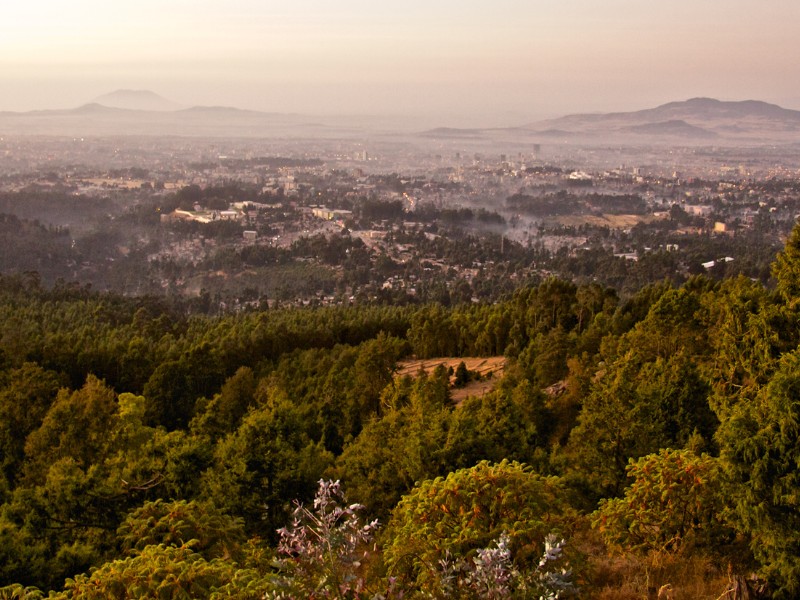
Day Trips From Addis Ababa, Ethiopia
For those looking to delve deeper into the beauty and diversity of Ethiopia, here’s a guide to some of the most compelling day trips from Addis Ababa.
1. Entoto Mountains
Just a short drive from the bustling city streets, the Entoto Mountains offer a serene escape with breathtaking views of Addis Ababa. Visitors can explore the historical Entoto Maryam Church, the former palace of Emperor Menelik II, and the Entoto Natural Park. Hiking trails abound, leading through eucalyptus forests to panoramic viewpoints.
2. Debre Libanos Monastery
This important religious center, situated in the Ethiopian Highlands about 100 kilometers north of Addis Ababa, dates back to the 13th century. The journey offers stunning views of the Jemma River Gorge. Visitors can explore the monastery, visit the cave where Saint Tekle Haymanot prayed, and cross the Portuguese Bridge, rumored to date back to the 16th century.
3. Menagesha Suba Forest
Regarded as one of the oldest protected areas in Africa, the Menagesha Suba Forest is home to an array of wildlife and ancient giant trees. Hiking through this lush, green landscape provides a refreshing counterpoint to the city’s arid climate. It’s an ideal spot for bird watching, picnicking, and immersing oneself in nature.
4. Tiya Stelae Field
A UNESCO World Heritage Site, Tiya is renowned for its mysterious stelae, ancient carved stones marking a burial site from the 12th to 14th centuries. The site offers a fascinating glimpse into Ethiopia’s prehistoric past. It’s about 80 kilometers south of Addis Ababa, making it an accessible journey into history.
5. Adadi Maryam Rock-Hewn Church
Comparable to the famous churches of Lalibela but much closer to Addis Ababa, Adadi Maryam is a rock-hewn church with roots possibly stretching back to the 13th century. The church offers insights into Ethiopia’s rich religious traditions and architectural ingenuity. The site is often combined with a visit to the Tiya stelae for a full day of exploration.
6. Wenchi Crater Lake
The stunning Wenchi Crater Lake, about 155 kilometers west of Addis Ababa, offers an array of outdoor activities set against the backdrop of breathtaking scenery. Visitors can hike around the crater, ride horses along its paths, take a boat trip to the island monastery, or simply enjoy the hot springs. The area is a haven for nature lovers and photographers alike.
7. Mount Zuqualla
An extinct volcano located about 100 kilometers southeast of Addis Ababa, Mount Zuqualla offers a peaceful day trip destination. The mountain is sacred in Oromo culture, and at its summit lies the Zuqualla Monastery, surrounded by a crater lake. The hike up the mountain provides stunning views and the chance to see diverse flora and fauna.
8. Sodere Hot Springs
Situated along the Awash River, Sodere is a resort town known for its therapeutic hot springs. Visitors can relax in the warm waters, enjoy a swim in the pool, or spot some of the local wildlife, including baboons and various bird species. It’s a perfect getaway for those looking to unwind and soak up the Ethiopian sun.
9. Awash National Park
Though it might stretch the definition of a day trip, Awash National Park is a must-visit for wildlife enthusiasts willing to start early. The park features waterfalls, hot springs, and a wide variety of wildlife, including oryx, baboons, and over 400 bird species. The dramatic landscape of the Awash River gorge adds to the park’s allure.
10. Ankober
Once the capital of the Shewan Kingdom, Ankober offers panoramic views of the Great Rift Valley and insights into Ethiopia’s royal history. The ruins of Emperor Menelik II’s palace and the beautiful Ankober Palace Lodge make it a fascinating destination for history buffs and those seeking tranquility alike.

Addis Ababa Transportation Guide
Whether you’re a local resident or a visitor exploring the city’s rich cultural tapestry, understanding the transportation system is key to a smooth experience. Here’s a comprehensive guide to getting around in Addis Ababa:
1. Bajaj (Blue and White Taxis)
- Description: Bajaj, also known as three-wheeled taxis or auto rickshaws, are ubiquitous in Addis Ababa. They are an affordable and convenient way to travel shorter distances within neighborhoods.
- Tips: Agree on the fare before starting your journey as Bajaj do not have meters. They can be hailed on the street and are perfect for navigating narrow roads where larger vehicles might not pass.
2. Minibus Taxis
- Description: Minibus taxis are the most common form of public transportation in Addis Ababa, serving established routes throughout the city. They’re recognized by their white and blue colors and are known for being fast-paced and efficient.
- Tips: Fares are very affordable but vary depending on the distance. It’s helpful to know some basic Amharic phrases to communicate with the driver and conductor, as minibuses are usually crowded and operate on a first-come, first-served basis.
3. Light Rail
- Description: The Addis Ababa Light Rail is a modern transit option inaugurated in 2015. It has two lines that cross the city, offering a reliable and relatively quick way to get around major areas.
- Tips: Tickets can be purchased at stations, and it’s advisable to avoid rush hour times when the trains can be very crowded. The light rail connects key parts of the city, including commercial districts and neighborhoods.
4. Ride-Hailing Services
- Description: Ride-hailing apps like Ride (the Ethiopian equivalent of Uber) offer convenient transportation options through a mobile app, providing a safer and more comfortable ride option.
- Tips: Fares are higher than minibuses or Bajaj but offer door-to-door service. It’s a preferred method for travelers who prioritize comfort, safety, and those unfamiliar with the local language.
5. Contract Taxis
- Description: Contract taxis are private cars available for hire for specific journeys or a full day of service. They do not follow specific routes and can be arranged for personalized tours around the city or to specific destinations.
- Tips: Prices should be negotiated beforehand. This option is ideal for groups or families who want the convenience of a private vehicle without the hassle of driving in Addis Ababa’s traffic.
6. City Buses
- Description: The city bus system, operated by the Anbessa City Bus Service Enterprise, offers extensive coverage across Addis Ababa. These buses are larger and can accommodate more passengers than minibuses.
- Tips: Buses are a cheaper option but can be slower due to frequent stops and varying levels of crowdedness. Understanding bus routes and numbers is essential for using this service effectively.
7. Walking
- Description: For those staying in central areas, walking can be an enjoyable way to see the city up close, especially in areas like Piazza, Meskel Square, and along Bole Road.
- Tips: Pedestrian infrastructure varies across the city, so caution is advised, especially when crossing streets. Walking is best suited for short distances and exploring neighborhoods.
8. Bicycles
- Description: While not the most common mode of transportation, bicycles are used by some residents of Addis Ababa, especially in less congested areas.
- Tips: Due to the city’s hilly terrain and busy traffic, cycling is recommended for experienced cyclists. Some hotels and hostels offer bike rentals for guests.

Where To Visit After Your Trip To Addis Ababa?
Here’s a list of destinations that offer a deeper dive into the country’s unique heritage and natural beauty, making them perfect follow-up trips after your Addis Ababa adventure.
1. Lalibela
Known for its remarkable rock-hewn churches, Lalibela is a UNESCO World Heritage site and a spiritual center for the Ethiopian Orthodox Christian faith. Carved from solid rock in the 12th and 13th centuries, these churches are an architectural marvel and offer an unparalleled glimpse into Ethiopia’s medieval past.
2. Gondar
Often referred to as the “Camelot of Africa,” Gondar was the royal capital of Ethiopia in the 17th and 18th centuries. The city is famous for its castles and palaces, particularly those within the Royal Enclosure, and the stunningly decorated Debre Berhan Selassie Church.
3. Simien Mountains National Park
A paradise for trekkers, the Simien Mountains offer dramatic landscapes, including deep valleys, jagged peaks, and rare wildlife such as the Ethiopian wolf and Gelada baboons. The park is a UNESCO World Heritage site and provides some of the most breathtaking trekking routes in Africa.
4. Axum
The ancient city of Axum, or Aksum, is the heart of early Ethiopian civilization and a UNESCO World Heritage site. Here, visitors can explore archaeological wonders like the obelisks (stelae), the ruins of Queen Sheba’s Palace, and the Church of St. Mary of Zion, believed to house the Ark of the Covenant.
5. The Omo Valley
Home to an astonishing array of ethnic groups, each with its distinct language, culture, and traditions, the Omo Valley offers a fascinating glimpse into Ethiopia’s rich ethnic diversity. This remote area provides opportunities for cultural visits to local villages, where traditions have remained largely unchanged for centuries.
6. Danakil Depression
One of the most extreme and spectacular landscapes on earth, the Danakil Depression features active volcanoes, vast salt flats, and colorful hot springs. Visiting this otherworldly destination offers a once-in-a-lifetime adventure, though travelers should be prepared for the challenging conditions.
7. Harar
The walled city of Harar is considered the fourth holiest city in Islam and boasts 82 mosques and 102 shrines. It’s known for its vibrant markets, unique Harari architecture, and the tradition of feeding wild hyenas that come to the city walls each night.
8. Bahir Dar and Lake Tana
Bahir Dar, situated on the southern shore of Lake Tana, Ethiopia’s largest lake, serves as a gateway to the Blue Nile Falls and the lake’s island monasteries, which are adorned with beautiful frescoes. The city’s palm-lined avenues and lakeside setting make it a relaxing place to unwind.
9. The Bale Mountains National Park
Offering a stark contrast to the arid landscapes of the Danakil, the Bale Mountains are a haven of alpine moorlands, cloud forests, and abundant wildlife, including the Ethiopian wolf. The park is perfect for hiking, bird watching, and experiencing Ethiopia’s high-altitude landscapes.
10. Awassa
Awassa (or Hawassa) is a laid-back lakeside city in the Rift Valley, known for its vibrant fish market, beautiful lake views, and excellent birdwatching opportunities. It’s a great spot to enjoy a slower pace of life while still experiencing the natural beauty and culture of Ethiopia.
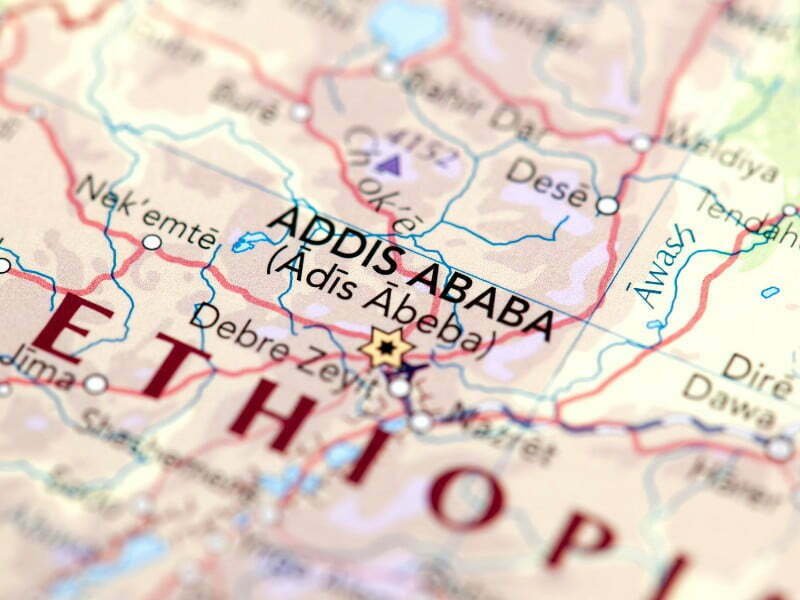
Essential Addis Ababa Travel Questions Answered: First-Timer Tips, Local Etiquette, Safety, Budget & Planning Smarts
How many days should I spend in Addis Ababa?
It depends. If Addis is mainly your gateway to the rest of Ethiopia, you can still have a meaningful visit in 1–2 full days by focusing on a museum, a cathedral, a market, and a proper food-and-coffee night.
If you want to slow down and actually feel the city’s rhythm, three days is a great sweet spot. That gives you time for history, food, a panoramic viewpoint like Entoto, and one lighter cultural day without sprinting between neighborhoods.
What is the best time of year to visit Addis Ababa?
Absolutely. Addis sits high enough that it stays pleasantly mild compared to many African capitals, so you’re rarely battling extreme heat.
Most travelers find the drier months easiest for sightseeing and day trips, while the main rainy season generally falls in summer (roughly June to September). If you’re aiming for clearer skies and easier logistics, the dry stretch is usually the safer bet for a first-time visit.
Is Addis Ababa safe for tourists?
Yes. With normal big-city awareness, Addis can feel surprisingly manageable, especially in central areas and well-trafficked neighborhoods.
Your biggest day-to-day risks are likely petty theft and opportunistic pickpocketing in crowded places like Mercato or on busy streets. Use a crossbody bag, keep phones tucked away, and consider a guide for your first market visit. Also stay alert around demonstrations and follow local advice if anything feels off.
What area should I stay in for a first visit?
Not really a one-size-fits-all answer, but the choice is easier than it looks.
Bole is modern, convenient, and packed with dining options and hotels. It’s a comfortable first base if you like easy logistics. Piazza offers a more historic vibe and walkable old-city energy. Arat Kilo works well if your priorities are museums, government landmarks, and a slightly calmer, central feel.
If it’s your first trip, we’d lean Bole for comfort or Arat Kilo for a balanced, central base.
How do I get from Bole International Airport to my hotel?
Yes. The simplest options are official airport taxis or pre-arranged hotel transfers. If you’re arriving late at night or you’re tired from a long haul, the small extra cost of a hotel pickup is worth it for stress-free navigation.
Ride-hailing exists in the city, but at the airport it can be hit-or-miss depending on local conditions and your connectivity. Having your hotel address saved offline also helps.
How do I get around the city day to day?
Absolutely. For short hops, taxis and ride-hailing are the easiest solution for visitors. Addis traffic can be intense, so build in buffer time.
For budget-minded travelers, minibuses and city buses are cheap but can be confusing without local language help. The light rail is useful on certain corridors and can be a good experience if your route lines up with the stations.
Do I need a visa and what’s the easiest way to get one?
It depends. Many travelers can use Ethiopia’s eVisa system, which is generally the easiest option for a straightforward tourist visit. The official information for entry requirements and the eVisa portal is the best place to confirm eligibility for your nationality and the most current rules.
Even if the process is smooth, we’d still recommend applying with enough cushion before your flight and double-checking the entry airport requirements listed on official guidance.
What should I know about Addis Ababa’s altitude and staying healthy?
Yes. Addis is high—over 2,300 meters—and some people feel it on day one.
Take your first day slowly, hydrate more than you think you need, and avoid a heavy “go-go-go” schedule right after arrival. If you’re sensitive to altitude, a gentle museum day and an early night can make all the difference.
What cultural etiquette should I follow in churches and during the coffee ceremony?
Absolutely. For Ethiopian Orthodox churches, dress modestly and be prepared to remove your shoes in some settings. Photography rules vary, so asking first is always the respectful move.
For the coffee ceremony, the best etiquette is simple: slow down, accept the rhythm of the ritual, and treat it as a social moment, not just a caffeine stop. Even a small gesture of curiosity and patience goes a long way.
What’s a realistic daily budget in Addis Ababa?
It depends on your travel style. Budget travelers who use local transport and casual eateries can get by on a modest daily spend. Mid-range travelers will have a comfortable day with a mix of museums, taxis, and sit-down meals. Luxury stays and international restaurants push costs up quickly.
Because prices can shift and vary by neighborhood, we’d treat your hotel level as the biggest variable and then layer food and transport around that.
What foods should I prioritize if I only have one or two meals to “get” Ethiopian cuisine?
Absolutely. If you want the fastest route to “I understand Ethiopian food now,” order a mixed injera platter so you can sample multiple stews at once. Add doro wat if you like spice and want a classic.
If you’re adventurous, kitfo is iconic, but it can be served raw or lightly cooked—so you can choose your comfort level. Finish with a proper coffee experience rather than a quick espresso-style stop.
Is Addis Ababa good for families with kids?
Yes. The city has parks, big hotel facilities, and cultural sites that can be tailored to shorter attention spans. Places like Unity Park can be an easy family-friendly option if your group enjoys gardens, animals, and a lighter history dose.
The main challenge is traffic and walking conditions, so plan shorter hops and use taxis to reduce stress.
What are the best easy day trips from Addis?
Absolutely. Entoto is the easiest “half-day that feels like a full reset” thanks to greenery and city views. Religious and heritage-minded travelers often pair Addis with places like Debre Libanos or Adadi Maryam.
If you want a nature-forward escape with a bit more effort, crater lakes and hot spring areas are popular longer day options depending on road time and season.
What should I pack for Addis Ababa?
Yes. Pack for mild days and cooler evenings—layers are your best friend. A light jacket or fleece is useful year-round because the altitude can make nights feel crisp.
Comfortable walking shoes, a modest outfit for religious sites, and a rain shell if you’re visiting during the wetter months will cover most scenarios.
Addis Ababa Travel Guide: Final Thoughts
This city, a blend of past and future, offers an experience that is both profoundly educational and deeply moving. Here are some reflections and tips to consider as you either plan your journey or reminisce about your time in Ethiopia’s vibrant capital.
The Heartbeat of Ethiopia
Addis Ababa isn’t just a city; it’s the heartbeat of Ethiopia. It pulses with life, from the early morning coffee rituals to the late-night jazz sessions. The city’s diverse neighborhoods, from the historical Arat Kilo to the trendy Bole, offer glimpses into its multifaceted identity. This is a place where tradition and modernity coexist, creating a dynamic atmosphere that is both intriguing and welcoming.
Cultural Richness
One can’t help but be awed by the city’s cultural richness. The museums are treasure troves, the art galleries are bursting with creativity, and the music scene is vibrant. Each experience, whether it’s visiting the National Museum or catching a live performance at Fendika Azmari Bet, adds a layer of understanding and appreciation for Ethiopia’s artistic and historical contributions.
Culinary Adventures
The culinary adventures in Addis Ababa are a highlight. From traditional injera with flavorful stews in local eateries to international cuisine in upscale restaurants, the city caters to every palate. The coffee, however, is non-negotiable. Participating in a coffee ceremony is not just about tasting the brew but immersing in a ritual that’s central to Ethiopian social life.
A Testament to Resilience
Walking through Addis Ababa is to walk through a testament to resilience. The city, never colonized, stands proud, with monuments and landmarks speaking to its history of independence and its role in Pan-Africanism. It’s a reminder of the strength and endurance of the Ethiopian spirit, visible in the warm smiles and welcoming nature of its people.
Practical Tips for Travelers
- Getting Around: The city’s light rail system and a network of minibusses offer convenient ways to navigate, but for ease and comfort, consider hiring a private car or using ride-hailing apps.
- Stay Connected: Purchase a local SIM card for easy communication and access to maps and information.
- Embrace the Pace: Addis Ababa operates on its own rhythm. Embrace the leisurely pace of life here, especially when it comes to service in restaurants and cafes.
- Respectful Engagement: When visiting religious sites or engaging with local traditions, always approach with respect and curiosity. Ethiopians are proud of their culture and happy to share it with interested visitors.
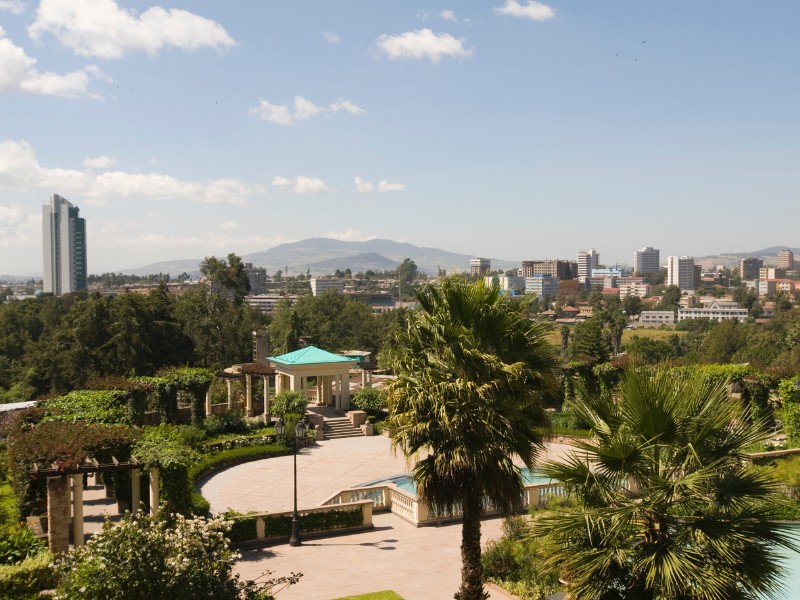
Ode To Addis Ababa
In Addis Ababa’s vibrant streets, Where modernity and tradition meet, The city pulses with a lively beat, As people move with dancing feet.
Amidst the hustle and bustle, A kaleidoscope of sights and sounds, The people of Addis Ababa Welcome travelers from all around.
From the scent of freshly brewed coffee, To the tantalizing tastes of cuisine, Addis Ababa’s flavors linger, Like a memory of a beautiful dream.
In museums and art galleries, The country’s unique history unfolds, As ancient tales are told Through treasures of bronze and gold.
And as you leave this dynamic city, With its charm and hospitality, Take with you the memories, Of Ethiopia’s rich diversity.
For beyond Addis Ababa’s bustling streets, A land of unparalleled beauty awaits, With mountains, deserts and ancient towns, That will leave you awe-inspired and amazed.
So let the spirit of Ethiopia, Guide you on your journey ahead, With memories of Addis Ababa, Forever etched in your heart and head.
